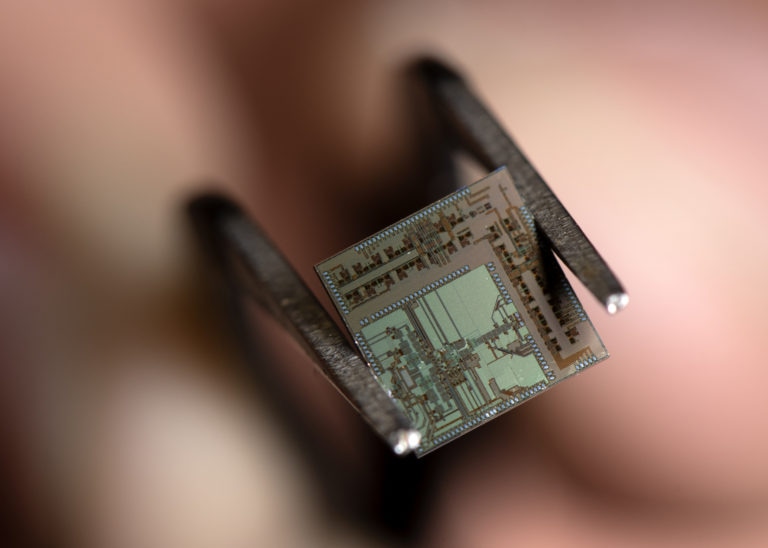Jul 18 2019
Electrical engineers at the University of California, Irvine (UCI) have invented a novel wireless transceiver that increases radio frequencies into 100-gigahertz territory, which is four times the speed of the upcoming fifth-generation—or 5G—wireless communications standard.
 The “end-to-end transmitter-receiver” chip boasts a unique architecture combining digital and analog components on a single platform, resulting in ultra-fast data processing and reduced energy consumption. (Image credit: Steve Zylius/UCI)
The “end-to-end transmitter-receiver” chip boasts a unique architecture combining digital and analog components on a single platform, resulting in ultra-fast data processing and reduced energy consumption. (Image credit: Steve Zylius/UCI)
The 4.4-mm2 silicon chip, dubbed “end-to-end transmitter-receiver” by its inventors in UCI’s Nanoscale Communication Integrated Circuits Labs, can process digital signals more energy-efficiently and more quickly. This can be attributed to its exclusive digital-analog architecture. The latest breakthrough has been described in a paper recently reported in the IEEE Journal of Solid-State Circuits.
We call our chip ‘beyond 5G’ because the combined speed and data rate that we can achieve is two orders of magnitude higher than the capability of the new wireless standard. In addition, operating in a higher frequency means that you and I and everyone else can be given a bigger chunk of the bandwidth offered by carriers.
Payam Heydari, Study Senior Author and Professor, Department of Electrical Engineering and Computer Science, UCI
Heydari is also the NCIC Labs director.
According to him, communications circuit engineers and academic researchers have long wanted to find out whether wireless systems are capable of the high speeds and performance of fiber-optic networks.
“If such a possibility could come to fruition, it would transform the telecommunications industry, because wireless infrastructure brings about many advantages over wired systems,” Heydari said.
His team’s solution is in the form of a novel transceiver that leaps considerably over the 5G wireless standard—selected to operate within the 28 to 38 GHz range—into the 6G standard, which is anticipated to operate at 100 GHz and above.
“The Federal Communications Commission recently opened up new frequency bands above 100 gigahertz,” stated postgraduate researcher and lead author Hossein Mohammadnezhad, who was a UCI graduate student during the work and recently received a PhD in electrical engineering and computer science. “Our new transceiver is the first to provide end-to-end capabilities in this part of the spectrum.”
It will soon become important to have receivers and transmitters that can manage such high-frequency data communications and thus bring in a novel wireless era controlled by autonomous vehicles, the “internet of things,” and hugely expanded broadband for streaming of various sophisticated technologies, including high-definition video content.
Although this digital dream has spurred technology developers for many years, stumbling blocks have started to emerge on the road to progress.
Heydari stated that varying frequencies of signals via demodulation and modulation in transceivers has been historically done through digital processing. However, in recent years, integrated circuit engineers have started to see the physical constraints of this approach.
Moore’s law says we should be able to increase the speed of transistors – such as those you would find in transmitters and receivers—by decreasing their size, but that’s not the case anymore. You cannot break electrons in two, so we have approached the levels that are governed by the physics of semiconductor devices.
Payam Heydari, Study Senior Author and Professor, Department of Electrical Engineering and Computer Science, UCI
In order to resolve this issue, researchers at NCIC Labs used a chip architecture that considerably relaxes the requirements of digital processing by modulating the digital bits in the radio-frequency and analog domains.
According to Heydari, besides facilitating signal transmission in the 100 GHz range, the exclusive layout of the transceiver enables it to consume significantly less energy when compared to present generation of systems at a decreased overall cost. This could eventually result in its extensive adoption in the consumer electronics market.
According to co-author Huan Wang, a UCI doctoral student in electrical engineering and computer science and also an NCIC Labs member, the technology in combination with phased array systems—which employ numerous antennas to steer beams—allows several disruptive applications in transfer and communication of wireless data.
“Our innovation eliminates the need for miles of fiber-optic cables in data centers, so data farm operators can do ultra-fast wireless transfer and save considerable money on hardware, cooling and power,” Wang stated.
Semiconductor fabrication services were provided by TowerJazz and STMicroelectronics to support the research project.